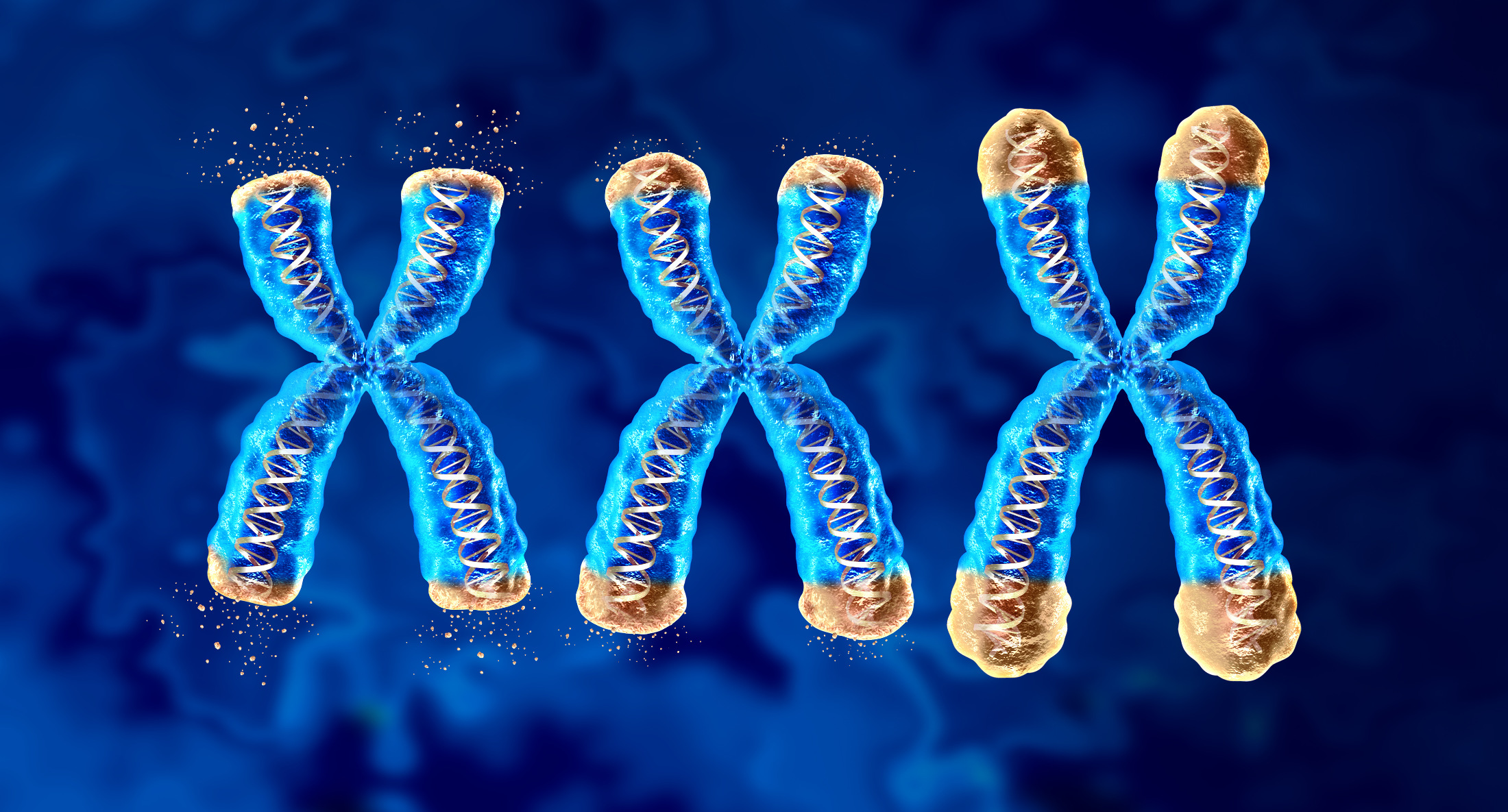
With every heartbeat, every cell division and every new day, a biological clock ticks deep inside you – and its hands are your telomeres. These tiny protective caps at the ends of your chromosomes play a crucial role in the ageing process. What used to be just a theoretical concept is now a central focus of longevity research: telomere wear and tear plays a key role in determining how quickly your biological age progresses. But the good news is that you have more influence on this process than you might think.
The DNA protective caps: What are telomeres?
Imagine your chromosomes as valuable scrolls whose ends are protected by special caps – the telomeres. These consist of repeated DNA sequences (“TTAGGG”) and comprise around 10-15 kilobase pairs. They are not just passive end pieces, but active guardians of your genetic information.
Together with special proteins, the so-called shelterin complex, the telomeres fold into characteristic T-loops. This structure prevents your chromosome ends from being falsely recognized as DNA breaks and protects against end-to-end fusions that could lead to dangerous genomic instability.
Without these protective caps, your cells would activate their DNA repair mechanisms and interpret the chromosome ends as damage – with catastrophic consequences for your cell health and ultimately for your lifespan.
Why our telomeres wear out
Every time a cell divides, it has to copy its genetic material. In doing so, it encounters a basic problem: at the very end of the DNA, a small piece always remains uncopied – comparable to a photocopier that cannot capture the last line of a page. These “missing ends” affect the telomeres, the protective caps of our chromosomes. They become slightly shorter with each division. At some point, they become so worn that the cell can no longer function or divide properly.
Unhealthy influences such as stress, smoking or poor nutrition further accelerate this wear and tear.
Scientists call this phenomenon the end-replication problem.

Telomerase: The enzyme of youth
However, nature has developed a solution to the end-replication problem: telomerase. This remarkable enzyme is a ribonucleoprotein that can add new DNA sequences to the ends of telomeres, thereby compensating for or even reversing telomere attrition.
Telomerase is a special enzyme that can lengthen telomeres again. It essentially consists of two parts:
- TERC, a short RNA sequence that serves as a blueprint for new telomeres, and
- TERT, the actual enzyme that attaches these pieces to the chromosome end.
Together they ensure that the telomeres do not shorten so quickly.
The catch?
In most of your body’s cells, telomerase is switched off after embryonic development. It only remains active in certain cell types, such as germ cells, stem cells and unfortunately also in many cancer cells – which explains why cancer cells seem to be able to divide indefinitely.
This evolutionary brake on telomerase activity is a double-edged sword: on the one hand it protects against uncontrolled cell growth and thus cancer, on the other hand it accelerates the ageing process.
When telomeres become critically short
As you age and the number of cell divisions increases, your telomeres become shorter and shorter. When they reach a critical minimum length, this triggers dramatic changes in the cell. The DNA damage at the unprotected chromosome ends activates a cellular emergency program: cellular senescence.
Senescent cells no longer divide, but remain metabolically active and begin to release a mix of pro-inflammatory molecules, growth factors and matrix-degrading enzymes – the so-called senescence-associated secretory phenotype (SASP). This cocktail damages the surrounding tissue and contributes significantly to age-related diseases.
Telomere attrition as a biomarker of biological age
Telomere length is now considered to be one of the most promising biomarkers for
biological age
. Interestingly, longer telomeres lose length faster than shorter ones, which makes them particularly sensitive indicators of the ageing process.
Using modern measurement methods, scientists can now analyze telomeres with unprecedented precision. These technologies make it possible to determine not only the average telomere length, but also the distribution of telomere lengths on different chromosomes – a decisive advance, as even a single critically short telomere can be sufficient to trigger cellular senescence.
Lifestyle interventions against premature telomere loss
Even though this all involves complex research, you can still influence the rate of telomere attrition yourself. It is now known that chronic stress, smoking, obesity and an unhealthy diet accelerate telomere loss, while regular physical activity, stress management and an antioxidant-rich diet can slow it down.
Editor’s note:
I know: these eternal lifestyle interventions seem almost too simple. But that’s the way it is. A healthy lifestyle is the best longevity medicine!
The findings on omega-3 fatty acids are particularly promising: a diet rich in these antioxidant fatty acids correlates with a reduced rate of telomere shortening. Vitamin C can also support the enzymatic activity of telomerase and thus possibly contribute to telomere lengthening.
This might also interest you:
Tired all the time? Discover the power of omega-3 fatty acids!
Telomere attrition and age-related diseases
The link between telomere attrition and age-related diseases is becoming increasingly clear. Studies show a threefold increased risk of premature heart attack in people with below-average telomere length. Telomere biology also plays a decisive role in type 2 diabetes mellitus and various types of cancer.
Telomere length is increasingly becoming a promising prognostic biomarker for cancer. A 2020 review found a clear correlation between shorter leukocyte telomere length and higher overall mortality rates in cancer patients.
These findings underline the central importance of telomere attrition as a driver of age-related diseases and open up new avenues for preventive and therapeutic approaches.
Did you know that magnesium has a direct influence on the health of telomeres? As a key factor in energy production and electron balancing, it helps to keep the protective ends of our chromosomes stable. An adequate supply of magnesium can even extend telomere length. Conversely, a deficiency, especially in conjunction with elevated homocysteine levels, is considered a risk factor for shortened telomeres.
>> Buy now
.
Your path to organic youth
Telomere attrition is not an inevitable fate, but a biological process that you can actively influence. With every healthy lifestyle choice you make – be it choosing nutrient-rich foods, regular exercise or effective stress management – you are protecting your telomeres and investing in your long-term health and vitality.
Telomere biology is on the cusp of groundbreaking developments that could revolutionize our understanding of aging and longevity. Until then, it is up to you to integrate the findings of telomere research into your everyday life and thus set the course for a longer, healthier life.
Sources:
frontiersin.org – Unlocking longevity: the role of telomeres and its targeting interventions
ncbi.nlm.nih.gov – The Hallmarks of Aging
nature.com – Digital telomere measurement by long-read sequencing distinguishes healthy aging from disease
ncbi.nlm.nih.gov – A Review of Telomere Attrition in Cancer and Aging: Current Molecular Insights and Future Therapeutic Approaches
salk.edu – Unveiling Telo-seq: A breakthrough in telomere research on aging and cancer
Ogłuszka M, Lipiński P, Starzyński RR. Effect of Omega-3 Fatty Acids on Telomeres-Are They the Elixir of Youth? Nutrients. 2022 Sep 9;14(18):3723. doi: 10.3390/nu14183723. PMID: 36145097; PMCID: PMC9504755.
🩺 Medically tested
This article has been professionally reviewed by Dr. Verena Immer. She is a doctor of integrative and anti-ageing medicine with a holistic approach that combines conventional medical knowledge with complementary methods. She has successfully applied the concept of individualized medicine in her own practice near Munich and currently offers personalized medicine – with a focus on longevity – in Switzerland.
Image source: istockphoto.com
- Age is just a number | credits @ NeonShot
- Reverse aging telomeres | credits @ wildpixel
Disclaimer
This blog is for general informational purposes only and does not constitute the practice of medicine, nursing or other professional health care services, including the giving of medical advice, and no doctor-patient relationship is established. Use of any information contained in this blog or materials linked to this blog is at the user’s own risk. The content of this blog is not intended as a substitute for professional medical advice, diagnosis or treatment. Users should not ignore or delay medical advice for any medical conditions they may have and should seek the help of their healthcare professional for such conditions.












